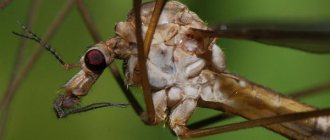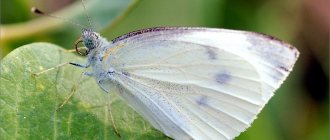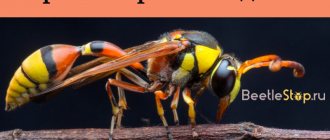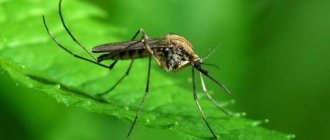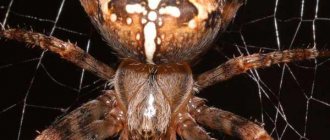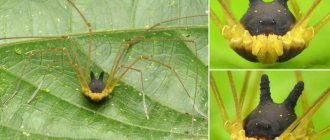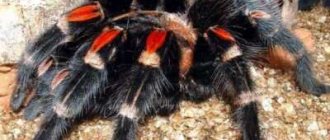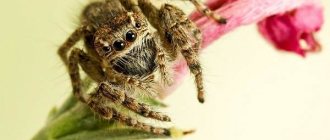The harvest spider (Pholcidae) is a frequent visitor and resident of human homes. Folcides are found on all continents of the world except Antarctica. In apartments they hang upside down on their irregularly shaped nets and scare people. There are more than 1,500 species of arachnids, each of which is special.
- Classification and habitat
- Behavior in the wild and in a private home
- Body size and structure Cephalothorax
- Abdomen
- Legtentacles
- Spider size
- Volcus phalangoides
- Ticks
Classification and habitat
Centipedes (as they are called informally) are representatives of araneomorphs. The family is divided into 80 genera. Among them are many synanthropes, common in human homes in almost all countries.
The spider lives on all continents except the South Pole. Arachnids build their dirty, asymmetrical networks in dark and damp recesses, such as caves, under stones, loose bark, and in abandoned mammal burrows. In human dwellings, pholcids are built in attics, basements and other untouched places in buildings.
A little about folk signs
There are many folk signs associated with these insects. Since ancient times, people have monitored house spiders and, based on their behavior, predicted important events that awaited the family.
Here are a few of them:
- if the spider crawls down, expect problems. It is much better if it creeps up - this is a profit;
- seeing a spider in the morning promises bad news; in the evening, on the contrary, it promises good luck;
- A large number of cobwebs under the bed for unmarried people promises new love acquaintances. A married couple needs to be more attentive to each other’s desires;
- if he crawls over money, expect unexpected financial income;
- The luckiest spider is white. Black is considered a bad omen and brings bad luck.
Not everyone now believes in omens, but there is one that even scientists agree on - you can’t kill spiders! And not because it will bring failure into your life. They are simply an integral part of the ecosystem. Small domestic arthropods are not dangerous to humans. At the same time, they catch harmful and bothersome insects such as mosquitoes and flies.
If house spiders appear in the apartment, you should expect improvement, quick success and the appearance of money. The same applies if the spider is on your head or arm.
Descending spider - guests will arrive soon or a message will arrive, but there will be an unfavorable time in financial matters. And a spider rising upward promises improvement and stability. If you see a spider hurrying upstairs in the evening, you should wait for your wish to come true.
The appearance of a cobweb or spider over the bed is a quarrel, betrayal or illness.
Seeing it in the kitchen in the morning means sad news, but if it happens in the daytime, you should expect joy. Meeting a spider in the kitchen in the evening is a sign of career growth, the fulfillment of a plan, or a promising meeting.
The spider wove a web and hid - towards the rain.
Seeing a spider sitting on you means a quick expensive new thing, a spider crawling means financial well-being, and a spider running away means loss.
Behavior in the wild and in a private home
The web of Pholcidae is not sticky; insects are held in it due to its irregular structure. Having discovered prey in the nets, the arachnid quickly wraps it in threads and inflicts a poisonous bite. If the predator is hungry, it eats the prey immediately; if it is full, it leaves it for later. After eating, the arthropod cleans the nets by unhooking and releasing the prey.
Some representatives have an interesting feature: when threatened, they begin to react with rapid vibrations of rotational movement in the web. Perhaps in this way representatives of the araneomorphs give a signal for the intended rival to leave.
The spider on thin long legs that lives in the apartment is quite cowardly. If chased, he will retreat into a corner or fall out of his web and run away.
Is it dangerous for humans?
This type of spider is not dangerous to humans, due to its inability to damage human skin with its weak jaws. Even if insect venom gets on the mucous membrane or in an open wound, its concentration will not be enough to cause harm.
We suggest you read: How long do spiders live in an apartment and in nature?
Many people are terrified of spiders and even a simple “watch” can instill fear in them. In this case, you just need to remove these uninvited guests from your home.
Body size and structure
Folcides, both in reality and in pictures, look unpleasant and unsightly. The body is oval, 2-10 mm in size. Thin legs extend from it, several times longer than the body. In some arthropods, the legs are 20 times larger than the body size.
The body consists of a cephalothorax and abdomen. It has a translucent but durable cover.
The family received its name due to its external resemblance to haymakers. The moss spider (as the harvest spider is popularly called) belongs to the order Opiliones. Although pholcids are also called braids.
Cephalothorax
There are 8 or 6 eyes located on the upper part of the rounded prosoma. The anterior medials are small or absent in six-eyed species. The secondary eyes are arranged in two triads. Chelicerae are located below the visual organs. They consist of a main segment articulated with the cephalothorax, and part of a canine aligned with the base segment. The canines look like scissors - leaning towards each other and intersecting in a pinching action. In males, the chelicerae have tooth-like growths, the lip is wide, fused with the sternum.
The carapace has a rounded shape with the head area often raised. The sternum is convex, with sinuous lateral parts, strongly shortened at the back.
Abdomen
The shape of the abdomen varies - from spherical to elongated cylindrical. The color of the abdomen ranges from pale gray to rich dark brownish gray. In some representatives the heart sign is clearly visible, in others it is slightly darker than the main color. There is a stripe located on the midline of the opithosoma. Holocnemus pluchel has spots instead of stripes, very similar to a giraffe. There are arachnoid warts on the lower anterior part of the abdomen.
Legtentacles
Haymaking spiders have 4 pairs of legs. They perform not only a basic function, but also a tactile function, helping to find food and run away from enemies. When walking, arthropods use an alternating tetrapod gait (first right leg, then second left, next third right, etc.).
Pholcidae have a valuable feature - the ability to restore a lost organ. If you grab an arachnid's paw, it will throw it away, and later the leg will recover.
Spider size
Pholcidae are spiders with a small body and long, fragile, but nimble legs. The dimensions of the body do not exceed 1 cm, but the limbs of certain harvestmen reach 6-7 cm. Such an absurd structure does not prevent the protostomed predator from hunting well and quickly leaving the place of danger.
Centipede development stages
Adult flight occurs in mid-July. Females mate with males, and eggs are formed inside within a few days.
The mosquito lays numerous eggs in damp, moist soil. Clay substrate, turf, and peat are suitable for these purposes. At temperatures above 15 degrees Celsius, the larvae develop within 15 days. At the last stage they pupate. After half a month, adult adults appear. A huge mosquito produces only one population per year. In tropical countries, reproduction occurs constantly.
When eggs are laid in September, the larvae have time to develop to the pupal stage, after which they freeze. They can remain in this state for 11 months, but under favorable conditions they are born in early spring.
Interesting!
Adult centipedes are active at night and do not fly well. If a bright light hits them, they begin to frantically beat against the glass, trying to get free. The bite of a large mosquito is nothing more than fiction. For humans, this is one of the most harmless creatures from the world of insects.
Externally, the centipede larvae resemble a caterpillar or worm. Gray in color, the body is divided into segments, moves with the help of small legs, short antennae on the head, and two tail-like appendages in the back of the body.
Types of harvesting spiders
The taxonomy includes over 1500 species, contained in more than 80 genera. A description of each can be found in the World Spider Catalog, an online database related to arachnid taxonomy. 11 species from three genera have been registered in Russia. Basically, these are syninthropes living next to people.
- Pholcus phalangioides;
- Pholcus opilionoides;
- Psilochorus simoni;
- Spermophora senoculata and others.
Psilochorus is found in the wild in the south of the Russian Federation.
Volcus phalangoides
Pholcus phalangioides is a home dweller, a representative of the family Pholcidae. Some call it a spider skull, due to the similarity of the cephalothorax to a human skull. He lives on the ceilings of rooms, garages, basements. It is considered useful because it kills other arachnids, including dangerous ones (hobos, red spiders).
The species was first recorded and described in 1775 by entomologist Johann Fussli. Females grow up to 9 mm, males are slightly smaller. The dimensions of the legs are approximately 5-6 times the length of the body. In females it reaches seven centimeters.
The abdomen is cylindrical in shape. The female with oocytes has a ball-shaped abdomen. The chitinous cover is yellow-brown with dark gray and beige markings. There are 2 dark gray spots on the cephalothorax.
Initially, representatives inhabited the warm western parts of the Palaearctic. With the help of people, Sinanthropus has spread throughout the world. It does not tolerate cold weather and is limited to heated houses in parts of its range.
Volcus phalangoid is not aggressive; the reaction to a threat is a strong shaking of the web. It feeds on other arachnids, even large ones, such as Eratigena atrica, mosquitoes, and woodlice.
Crossoprizalyoni
People call it a spider with long thin legs. Prefers to live in artificial habitats created by people. The “homeland” of the species is unknown. It was introduced to other parts of the world by accident. Currently widespread.
Crossoprizalyoni is characterized by sexual dimorphism. Females grow up to 3-7 cm, males - 2.5-7 cm. Males have longer legs than females, the first pair of limbs reaches up to 6 cm. The paws are gray to amber in color, and covered with brown spots.
The cephalothorax is wider, the carapace is subcicular. In the middle of the upper surface there is a deep depression, darker. Arthropods have 6 pearly white eyes located at the tip of the prosoma. Opisthosoma is gray with white lateral stripes. The abdomen is angular, box-like, with a large conical hump on the upper back.
A single male is capable of copulating with several females. The mating process lasts about 40 minutes. Unlike most other arachnids, Crossopriza lyoni females rarely eat their partner after mating. The new generation hatches 11-13 days after laying the eggs. The average life expectancy is at least 194 days.
The representatives are not considered dangerous, but the ubiquitous webs irritate people, and they try to fight the spiders.
Physocyclus globosus
The arachnid is known as the short-haired cellar spider. It lives in cool, damp, dark rooms, in nature - in caves in warm parts of the world.
Like all representatives of pholcids, Physocyclus globosus is long-legged. This is a small brown protostomed animal (body length - 6 mm) with a short, wide belly. A black stripe runs along the back of the shell and most of the belly. There are 8 eyes located at the elevation of the cephalothorax.
Smeringopus pallidus
A fairly common type of long-legged spider. Typically found in dusty, dark rooms (closets) and corners of the house (behind closets). It can also build webs under covered drains, on the walls of buildings, and in gardens. They hang upside down in a web and, when in danger, vibrate strongly to confuse the attacker.
As with other species, the male is smaller than the female - on average, about 7 mm. The abdominal cavity is cylindrical and elongated. On the dorsal surface of the abdomen there are purple spots characteristic of this species. The legs are covered with hairs, without spines.
Synanthropic arachnids build asymmetrical webs in sheltered areas to catch flies, mosquitoes, bees and other spiders for food.
Psilochorus simony
The pigtail lives in the wild in Mexico and South America. In countries with colder climates, it lives in houses and buildings created by man. The protostomes are small, body length 1.9-3 mm. The cephalothorax is light brown, with a dark spot in the middle. There are 8 eyes in two rows at the top. Opisthosoma is oval, humpbacked, brown in color with gray spots. Legs – from yellow to light brown tones.
Lifestyle
Most species hunt at night.
During the day they hide in the shade, hiding from sunlight. Sometimes they can be seen on the walls of buildings, frozen with their legs splayed to the sides. Pets hide in apartments in secluded places - in corners, behind furniture, in the bathroom. They can weave their web in places where it is difficult to reach during cleaning - under the ceiling or near windows. Spiders' webs are very large and can wrap around entire corners. One spider can weave around one corner and then move to the next. Spiders are very shy. If an enemy appears, the spiders flee from him, developing a fairly high speed.
What does it eat?
Pholcidae are predators, feeding on flies and mosquitoes. But there are species that invade the webs or nests of other spiders and devour the host, oocytes or prey. Pholcids move other people's webs, imitating the struggle of trapped prey, in order to lure the owner closer.
What do harvest spiders eat in the forest in winter when there are no flies? When harvesters are hungry, they hunt on their own, without waiting for the prey to be caught in the net. During the cold months, not all insects sleep in burrows until spring. Butterflies hiding in hollows and beetles hiding under the bark become prey.
Ticks
Ticks are a rare “product” of the diet of pholcids. When caught in a fragile web, they bite the threads and easily free themselves before the predator arrives. Sometimes arachnids feed on the prey of spider mites, devouring their hosts at the same time.
flies
Diptera insects are the main “dish” of the long-legged spider’s diet. The beauty of having a folcid in your apartment is its ability to help maintain balance. Harvesters feed on other domestic arachnids and pests. Flies, annoying carriers of gastrointestinal infections, are kept under control in people's homes thanks to the presence of the long-legged spider.
Aphid
Aphids live in places with succulent vegetation. In the wild, during the cold season, a hungry spider eats overwintering eggs left by females under the bark of trees. Adults are caught in nets, but not often.
Beetles
The representative of arachnids is quite voracious and indiscriminate in food. When food is scarce, such as in winter, it feeds on house bugs. Woodlice, ants, cockroaches, and carpet beetles are caught in the web of a long-legged spider or other arachnids. Hungry pholcids are not embarrassed that the victim is caught in someone else's net; the arachnids barbarously climb into them and eat the prey.
Mosquitoes
Mosquitoes try to settle near people's homes. They live in crevices of buildings and damp basements. During the day they sit on the ceiling waiting for a victim. In all these places, the haymaker spider places its webs, which insects stumble upon. Their size and weight do not allow them to break the web; mosquitoes often become prey for protostomes.
Who needs long legs?
The harvestman has long legs, which he can easily handle. Nature has thought out a unique principle for controlling these limbs. The legs are bent with the help of the muscle that pulls the tendon (muscular-mechanical action). They unbend from the pressure of the hemolymph, which accumulates inside (hydraulic action). Such a well-oiled mechanism is incredibly economical: it avoids the need for many small muscles. A haymaker can easily wrap its paw around any blade of grass or small pebble. The walking pigtail easily overcomes obstacles and can move even in hot or cool weather, carrying its body high above the surface.
The mechanism of movement of the haymaker interested specialists in the field of bionics (applied science that studies the use in technology of the principles of functioning of living forms). Kosinozhki give ideas to writers and artists, they are developed by specialists who are working on creating... walking vehicles for studying other planets.
Such an automatic machine is thought of as a walking device, which has a number of advantages over a wheeled or tracked automatic machine, especially in terms of orientation and overcoming obstacles. The equipment intended for research and movement is concentrated in a sealed capsule rising on several long, articulated legs. There are sensors at the ends of the legs and in the joints that send information about the contact of the leg with the substrate and its relative positions, according to which further coordinated movements are programmed at each moment. A walking automaton will be able to navigate by touch, bypass and overcome obstacles. ... The technical principles of operation are the same even in detail. For example, it is believed that to set the legs in motion, the most appropriate combination of mechanical and hydraulic principles is observed in the paw of a harvestman: flexion due to a cord passing through the segments to the end of the leg, and extension by the pressure of the fluid filling the leg (“Life of Animals” , volume III).
At the first danger, the haymaker easily loses his limbs. The wound heals instantly, so there is no loss of hemolymph. The severed leg continues to twitch for some time (up to half an hour). This occurs due to the voluntary contraction of special muscles. Lizards act in a similar way when they give their tails to the enemy. Autotomy (this is what the “voluntary” loss of body parts is called) often saves an animal from death. Haymakers losing part of their legs is a common occurrence. Their legs, unfortunately, do not recover.
The longest is usually the second pair of legs. The male common harvester has up to 54 mm. These legs read information about the state of the ground, stone or other support. Red dots on the legs or body are the larvae of ticks that have attached themselves to the braids.
Should you be afraid of the haymaker?
Pholcidae live in human homes, often annoying them with their appearance and ubiquitous webs. This negative attitude gave rise to the legend that arachnids have the most dangerous venom of all spiders. The stories are fueled by the fact that pholcids hunt other poisonous "brethren" that can cause serious trouble to the person they bite.
In reality, haymaking spiders throw webs over their poisonous victims and immobilize them. The process is carried out at a safe distance. Pholcids eat prey after it loses its ability to cause harm.
Small and weak chelicerae cannot pierce the thick skin of people. The poison is slightly toxic to insects and poses no danger to humans. When bitten, you may feel a slight burning sensation, but this is a reaction to an external irritant.
Interesting representatives
In nature, there are more than 4 thousand varieties of this family, some of them have such an attractive appearance that they are admired like butterflies.
The festive centipede or decorated ctenophora leaves no one indifferent and does not cause fear. The name speaks for itself. The photo is shown below.
Festive centipede
It lives in our area and is included in the Red Book of Russia and Ukraine. Body length reaches 26 mm. He practically cannot fly, although his wings are quite large. It also bites, feeds on the juices of plants, fruits, and nectar. The larvae are pests and damage deciduous trees.
Amazing color with black, yellow, orange, brown. The abdomen is striped, slightly reminiscent of a wasp. The same long limbs, but colored black and orange. Males have lemon-colored antennae. Insect larvae develop in rotten wood and old hollows. The reason for the extinction of the species is intensive deforestation of broad-leaved forests.
